
A Step Upwards
An interview with Līga Spunde
A good friend and I were recently discussing why the introductions to interviews rarely describe the atmosphere of the meeting. My guess was rather banal, but potentially realistic: due to time constraints, people are increasingly interested only in facts. Moreover, a large part of interviews are conducted remotely. I also end up meeting with Līga Spunde over Zoom because our previously scheduled meeting in her studio had to be cancelled. This remote presence is as freeing as it is annoying, because it actually rebounds the direction and subtexts of our conversation.
Līga is one of Latvia’s most prominent digital artists, with an unmistakable and very strong signature style. Her works are visual maps saturated with colours, images and cultural (including pop culture) references, giving the reader or viewer the opportunity to see social reality, society and history from a different perspective. Her digital installation Episodes About Not Knowing How It Will Be has been nominated for the 2023 Purvītis Prize, but in our virtual conversation we focus on other themes. From Līga’s participation in the Around Video fair in Lille and her collaboration with Kogo Gallery in Tartu, to digital detox and the monumental last harvest in the Latvian town of Madona.
Work by Līga Spunde at the Around Video fair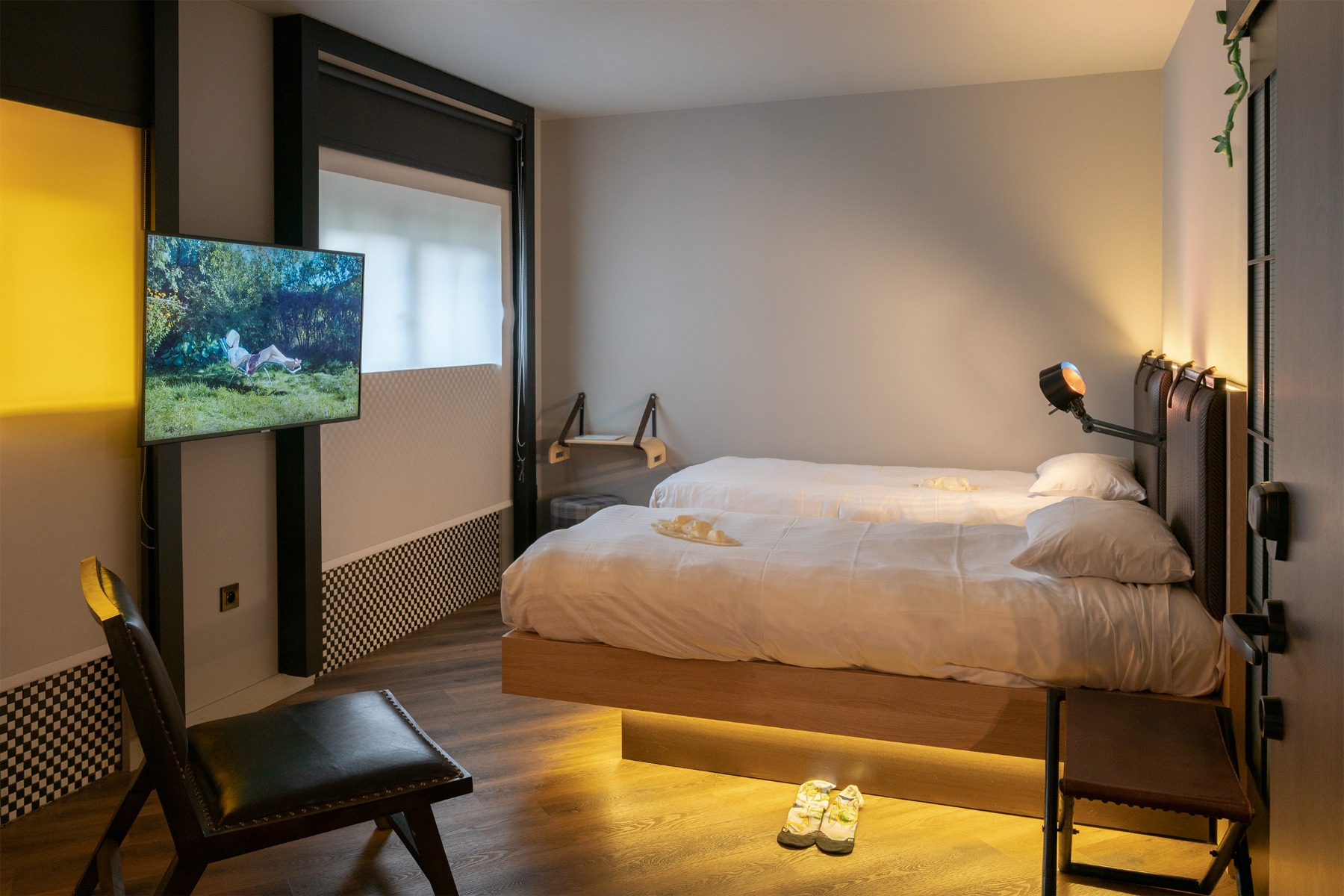
Could you start with the Around Video fair that is happening right now? How did you come to be involved in this project?
I came to this fair quite spontaneously. At the end of the summer, I was invited to take part in this adventure by Kogo Gallery, which has been representing me since April. They were aware that there was not much time to prepare, and I had the impression that this opportunity had come to them quite unexpectedly as well, and they now had to put something together in a short period of time. I accepted quite spontaneously, and I’m happy about that because it’s the first time I’ve had this kind of cooperation with Kogo. I also find the format of the video fair very interesting: it takes place at the Moxy Hotel Lille and all the video works are displayed on TVs or as projections in the rooms where the artists themselves live.
So you live in the room in which your work will be exhibited, and it is also open to the public during the day?
Yes. I understand that they have a time limit for visitors – from what time to what time these rooms are available – so I suppose it’s all balanced in a way that also allows for the artists’ privacy. I’m very interested in how this is going to work, because a hotel room is also a bit of a hiding place. But yes, that’s the format.
Work by Līga Spunde at the Around Video fair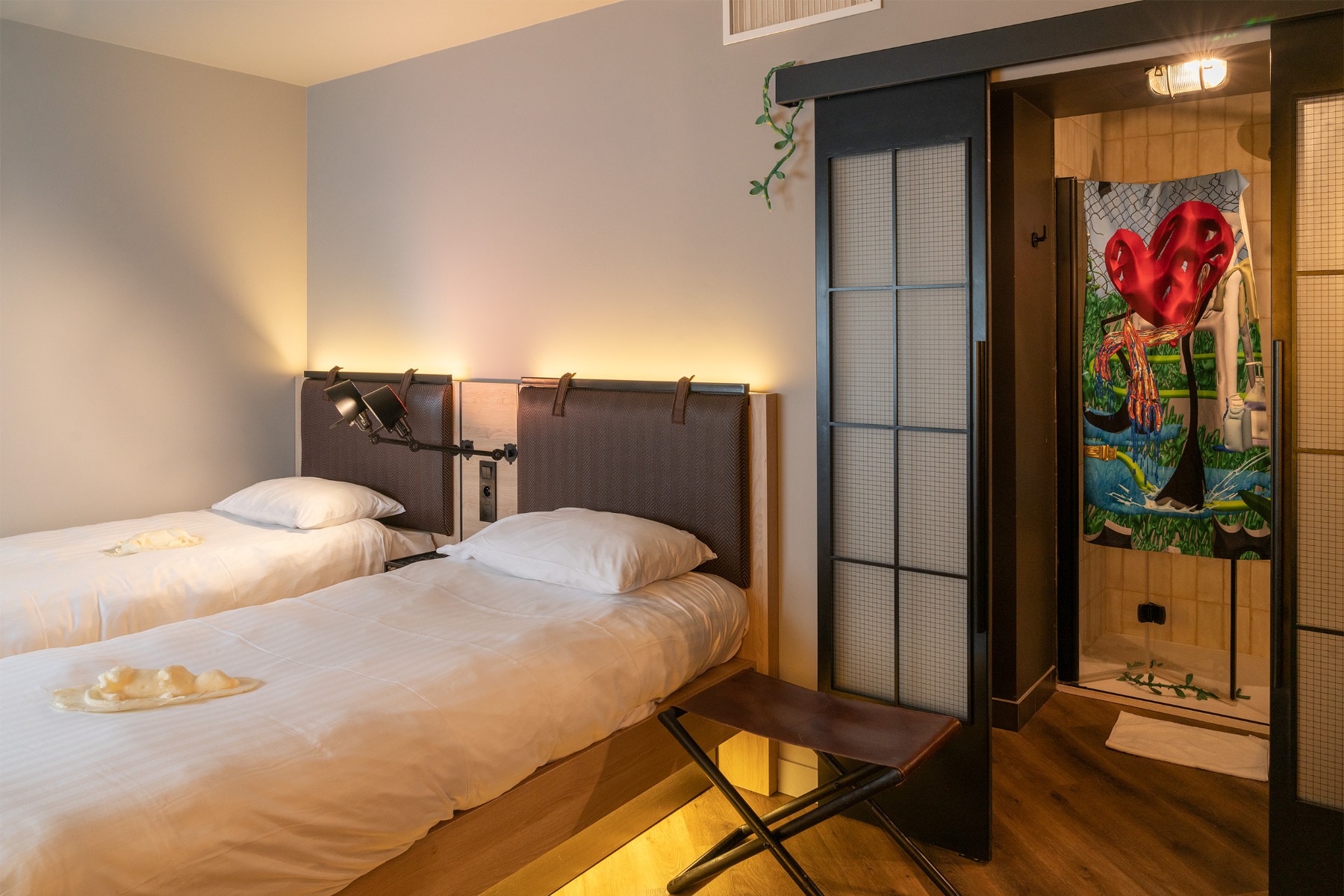
It’s interesting because you end up with a private space that’s on the edge of becoming too personal. You have to be prepared, in principle, to reveal yourself completely.
Well, yes – you have to make your bed in the morning.
But maybe you can play with these conditions, e.g. not make the bed and turn the space into an installation or an experience.
Yes, I think that’s an interesting option. Kogo and I have also come up with a way to work this situation, because it’s really unusual. I’m also participating in the fair with a video work that’s already finished – There’s No Harm In Any Blessings, which was shown at the Survival Kit 11 festival. So I was also thinking about how to incorporate these motifs from the installation and the video work into the hotel room environment. The two curators, Liina Raus and Šelda Puķīte, and I came to the same conclusion – that it would be a better idea to, for example, print a towel and put it in the room, rather than hanging large prints on the wall, which would become simple additions to the space. It’s difficult to work in a space like this, which is not meant for exhibitions, and there are a lot of restrictions concerning what you can screw or nail into the walls. So you have to think innovatively. And that’s exactly what we have in mind – I have this printed towel and socks with me, which we’re going to try to use to inhabit the space somehow.
Work by Līga Spunde at the Around Video fair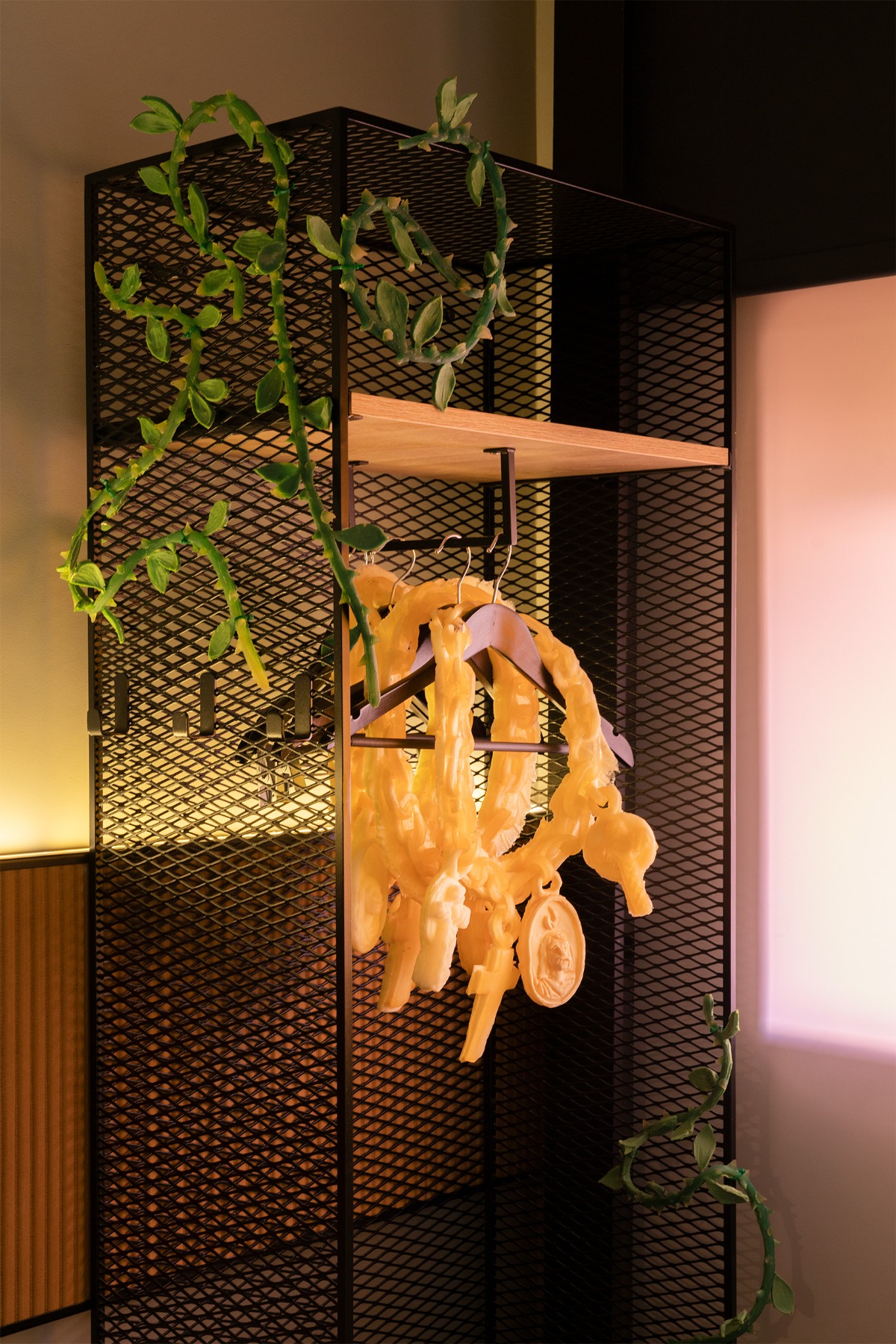
Is the installation moment in art always important to you? Because even though the focus of this fair is on video, you are also thinking about spatial additions.
I try to think about that, because often it also depends on the space. If the exhibition space is a “white cube”, then you can afford to think less about it, but if the space is specific, like in this case, or like the Maboca gallery that we just inhabited with Aleksandrs Breže, then I think there can be factors that are impossible to ignore. Then you have to work with the space, because otherwise the space could conflict with the installation in a way that would simply make the installation look like a foreign object. But yes, I love thinking about installation; it’s always an interesting process to see what you can do within a space – the techniques you can use to put artworks in it.
When you make new works, is it very important for you to know what kind of space they will be exhibited in?
It actually depends on the work. Right now I’m working on a series of works that are unconventional for me – I’m using the silkscreen technique. And I think of these works as very classical art, done in a traditional format. Consequently, the moment of installation and the space itself is not that important for me in this case. But in other cases, when creating a new work, I definitely try to take into account the space in which it will be exhibited.
Līga Spunde. “Sistēmas aritmija” (Arrhythmia of the system), 2021. Digital drawing. Exhibition 'Force[d] Majeure' at the Hanzas Perons territory. Photo: Ansis Starks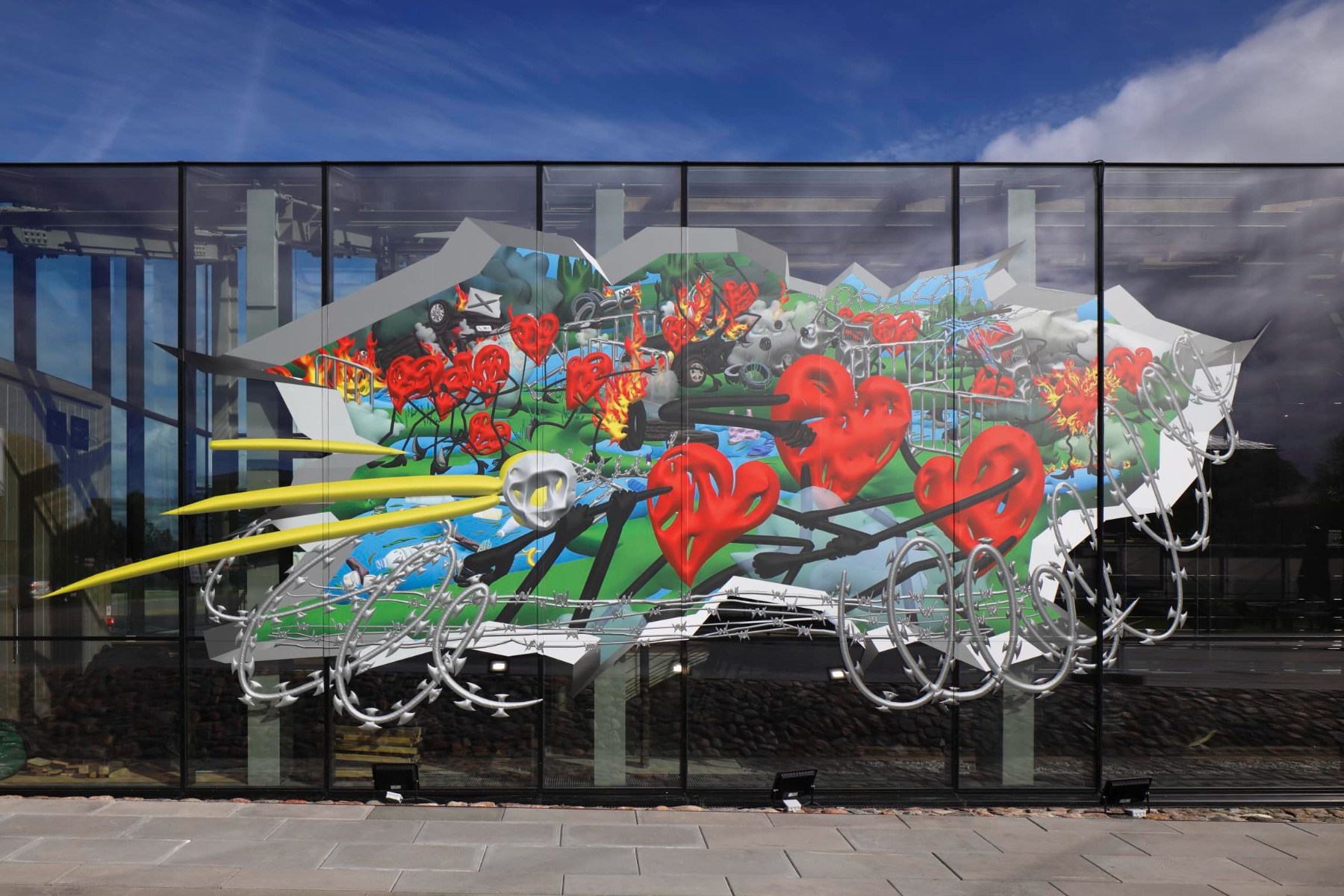
You already mentioned that you are participating in this fair together with Tartu’s Kogo Gallery. How did your collaboration develop?
Our collaboration started last year when Kogo hosted The Bambi Project, curated by Šelda Puķīte, in which she invited artists from all three Baltic States to participate. I think it was a mutually successful project. This summer, Titanik Gallery in Turku, Finland, hosted another group exhibition curated by Šelda and organised by Kogo, which also featured various Baltic artists. I haven’t had a solo show with them yet, but hopefully it will come with time.
What does it mean to you to be represented by a gallery now? And how do you see your relationship with an Estonian gallery in the Latvian context?
This is my first experience of being represented by a gallery and, to be honest, it’s a new format for me, so I’m not fully aware of what exactly it means. I think that will be revealed in the process of cooperation over time. But in the Latvian context, it’s very difficult for me to comment on what it means to be represented by a gallery. I personally know very few artists, from my generation in particular, who have been collaborating with a gallery long term. I think it’s no secret that there is a huge lack of contemporary art galleries in Latvia that have direct commercial interest. I think we have a quite strong and interesting artist-run sector, but there are very, very few commercial galleries. Of course, it all has to do with how easy or difficult it is to sell art in Latvia, the market, and also the support coming from the state. But if you look at western Europe, it’s quite normal that you are represented as an artist by a gallery. It should be like a step upwards. More opportunities, more international exhibitions, more collaborations. My experience of being represented by a gallery is still at the very beginning and, because of the circumstances I just mentioned, I am not surprised that the first gallery that has chosen to represent me is abroad. Estonia may not be far from us, but it’s still not Latvia.
Līga Spunde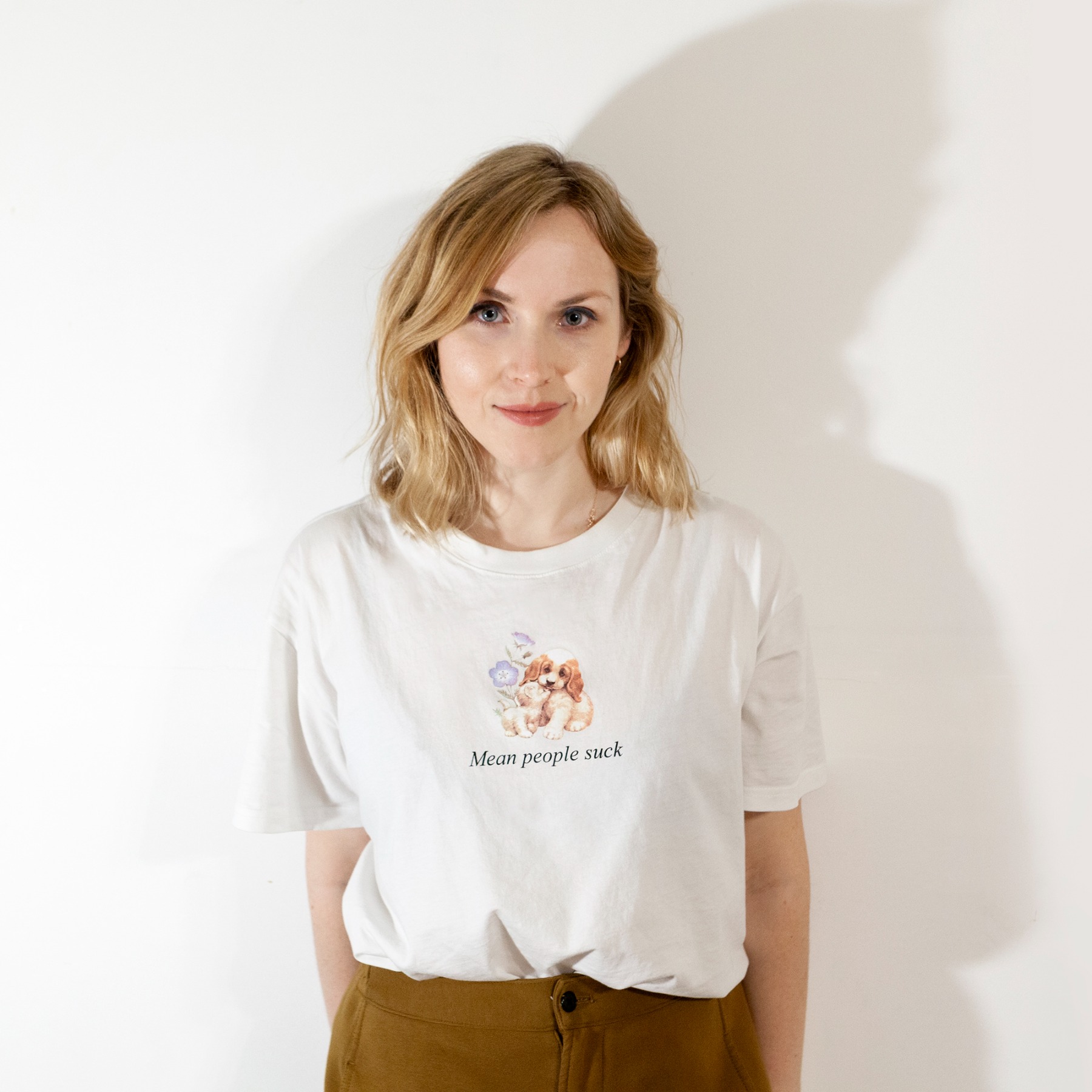
How do you feel when working in Latvia?
I think that’s a complex question. On the one hand, Latvia is a very cool place – it’s quite easy to do a lot of things and projects here, also on a collaborative level and in terms of getting work produced. I also can’t complain about state support, because I have been regularly supported by the SCCF, for which I am also very grateful. But in a broader perspective, the lack of a market is very strongly felt and, therefore, the support that is given is inevitably too small to be able to realise bigger ideas. Smaller projects, for instance, are much easier to implement than ambitious ones that require more funding, which is always difficult to attract.
Personally, I think that moral or psychological support is also very important in the sector, both in social relationships and at the national level.
In my experience, I would say that these relationships have become more supportive. I have been very lucky with the people I have met during my studies at the Art Academy of Latvia and elsewhere, who have given me the opportunity to publish something or have involved me in certain processes. That has been very, very important. I think the main problem is that the financial support is so small that there is inevitably some competition. Although it is very difficult to compete, because most of the areas that qualify for this funding are really needed – non-commercial galleries, commercial galleries, institutions, artists and authors. In such a situation, competition is a bit out of place. Another issue is the relationship between the art world and the non-art world. Especially in recent years, in the context of all these scandals, suddenly there has been this huge bewilderment regarding what is going on in contemporary art, and I think it’s shocking to both sides. Artists are shocked to see that many people don’t understand their work, while it’s shocking for the public to see what artists are doing these days. It’s actually very sad. It’s a hole that a lot of people talk about – we don’t have a contemporary art museum, the public is not interested, and there is no tradition in that regard. It’s not right to compare Latvia with foreign countries all the time, but having been to western Europe, you don’t get the impression that you have to be born into a family of artists to be used to going to museums from a young age. You just go to museums because schools and universities organise it, and because it’s a cool place! People go to museums with friends or on dates. It’s a place where interesting and valuable things happen. Living in Latvia, it seems that the circle of people interested in culture is small, unfortunately.
Līga Spunde. There Is No Harm In Any Blessing
Do you think about how the public perceives your work? Force[d] Majeure, the exhibition that took place last year at Hanzas Perons and was curated by Kim?, immediately comes to mind – there was the incident with Indriķis Ģelzis’ installation being vandalised. For example, in such a public situation, are you interested in interacting with the viewer?
Yes, of course I’m interested in that. I would say, however, at least I think so myself, that my works are filled with such a visual narrative that they are relatively easy to perceive and I don’t usually experience serious problems with the audience. Of course, people will always think: “like it – hate it”, “nice – ugly”, but I don’t take that very seriously. Although, it’s interesting, by the way, to know how people look at your art – how important aesthetics are to them. And whether that aesthetic meets some classical criteria of beauty. I have to admit that I haven’t had much experience in the public space. That particular work you mentioned, the collaboration with Kim? at Hanzas Perons, has also been my most ambitious.
Līga Spunde. There Is No Harm In Any Blessing
But if it is an exhibition for a gallery, do you take the audience factor into account when you create the artworks? Or do you always rely on your own intuition and desires?
Well, let’s put it this way – I don’t try to please the viewers in any way, but when I organise an exhibition, I try to approach the viewers with respect, thinking about how people will look at and interact with my work, as well as how they will move around the space – so that the space is accessible. Unless it’s part of my concept, I won’t make them have to overcome any obstacles. Honestly, I think more about the work itself than about the audience. But I do it knowing that the audience is present, and I think in terms of making the exhibition watchable, interesting, and visually pleasing.
Līga Spunde. There Is No Harm In Any Blessing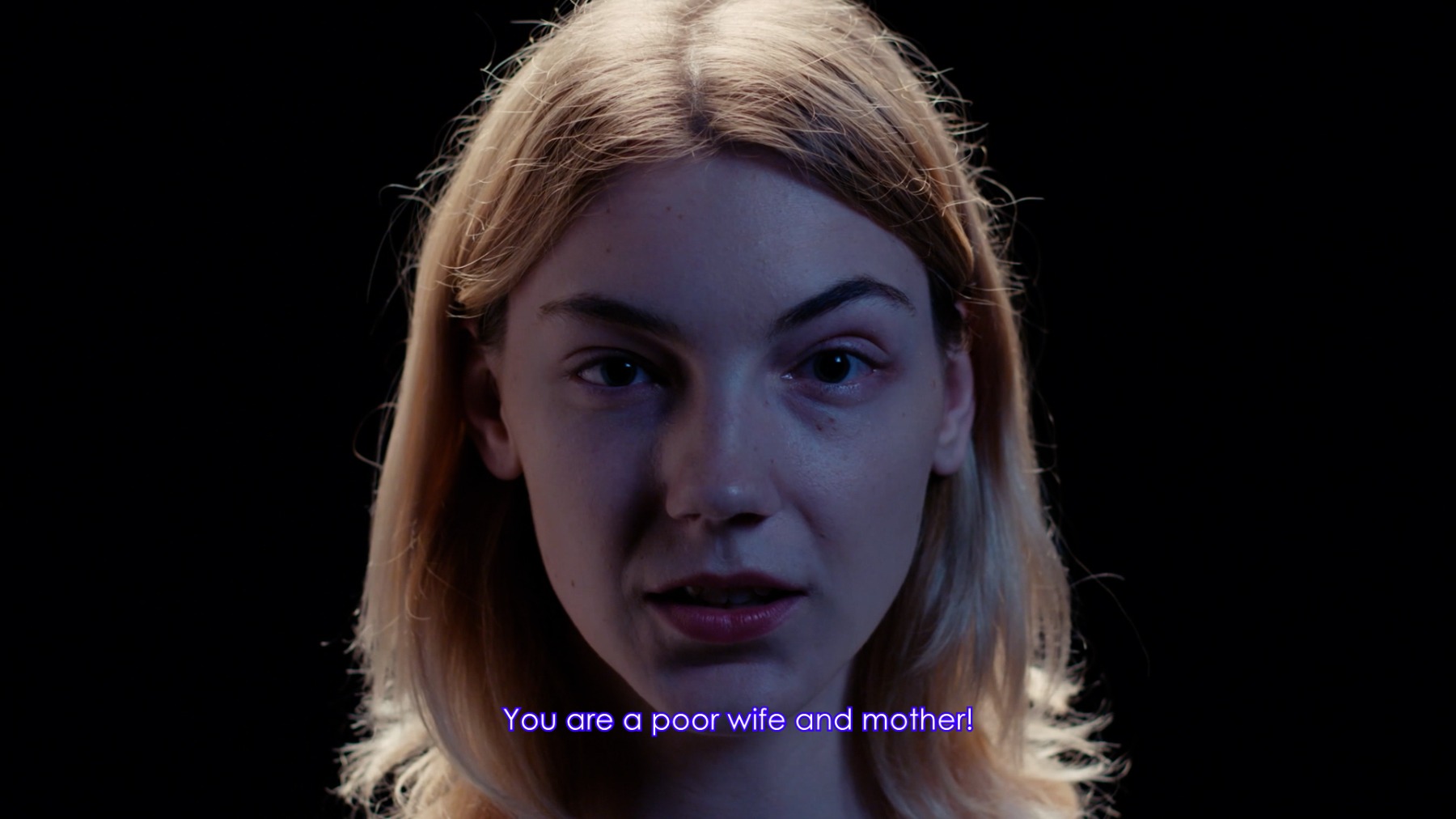
I’m asking you this question because it seems that social themes have crept into your work, especially recently. You have reflected on the Covid pandemic and what happens to people when they face isolation, and you also include quite a lot of historical references in your work. You put these codes in your work, and the work then carries the message on.
I guess it’s something to do with my enthusiasm; if I’m fascinated by a motif, then I really try to delve into it, dig deeper, look for more, look for similarities. And then in the works, the combinations are really created like codes that have many different keywords hidden within. I probably don’t even expect the audience to see them all – it’s more important for me to bring the composition to completion for myself. To feel that there is both a historical reference and items that correspond to an event or to my own experience. I was talking to Aleksandrs Breģis the other day – he has one of my pieces from the Kim? exhibition When Hell Is Full, the Dead Will Walk the Earth, and he said that was that piece that spoke to him because of the rotten.com sticker that can be seen on the monitor. Just one element that I put in there – deliberately, of course – which means nothing to many people, but to some people it just might be a reason to become interested in this work of art. In terms of context, I usually make my work very saturated and I enjoy encoding it that way – through symbols, small elements, extras or backgrounds.
What do you think – has your signature style evolved or changed during these seven years of professional activity?
Of course my signature style has evolved, and I feel that it is still evolving. Somehow I’ve been more focused on digital themes lately; it might not even be a conscious choice, but it just so happens that I have a lot to say about them. In the past, it was very important for me to include autobiographical motifs in my work. That hasn’t gone away; it has rather transformed because in my recent work I don’t show these experiences through stories as much as through images – it’s more visual. Working regularly, it would actually be sad to admit that there has been no progress and everything is exactly as it was seven years ago. Fortunately, there has been progress!
But in terms of themes and different materials, I’m faithful to what I find interesting. I’m experimenting more and more with all kinds of materials. For example, lately I’ve been interested in how to get digital drawings into a physical environment; there are various technologies that can be tried out. In fact, I’m still interested in narrative as well. For example, the video work that’s now on view at Around Video is based on a simply incredible story about a boy – Bubble Boy – that absolutely charmed me with its strangeness and tragedy. It was in my early work that I was interested in incorporating real-life situations, but now the digital aspect has strongly entered my practice and I’m trying to figure out what to do with it.
Līga Spunde. Last Harvest. 2022. Maboca gallery, Madona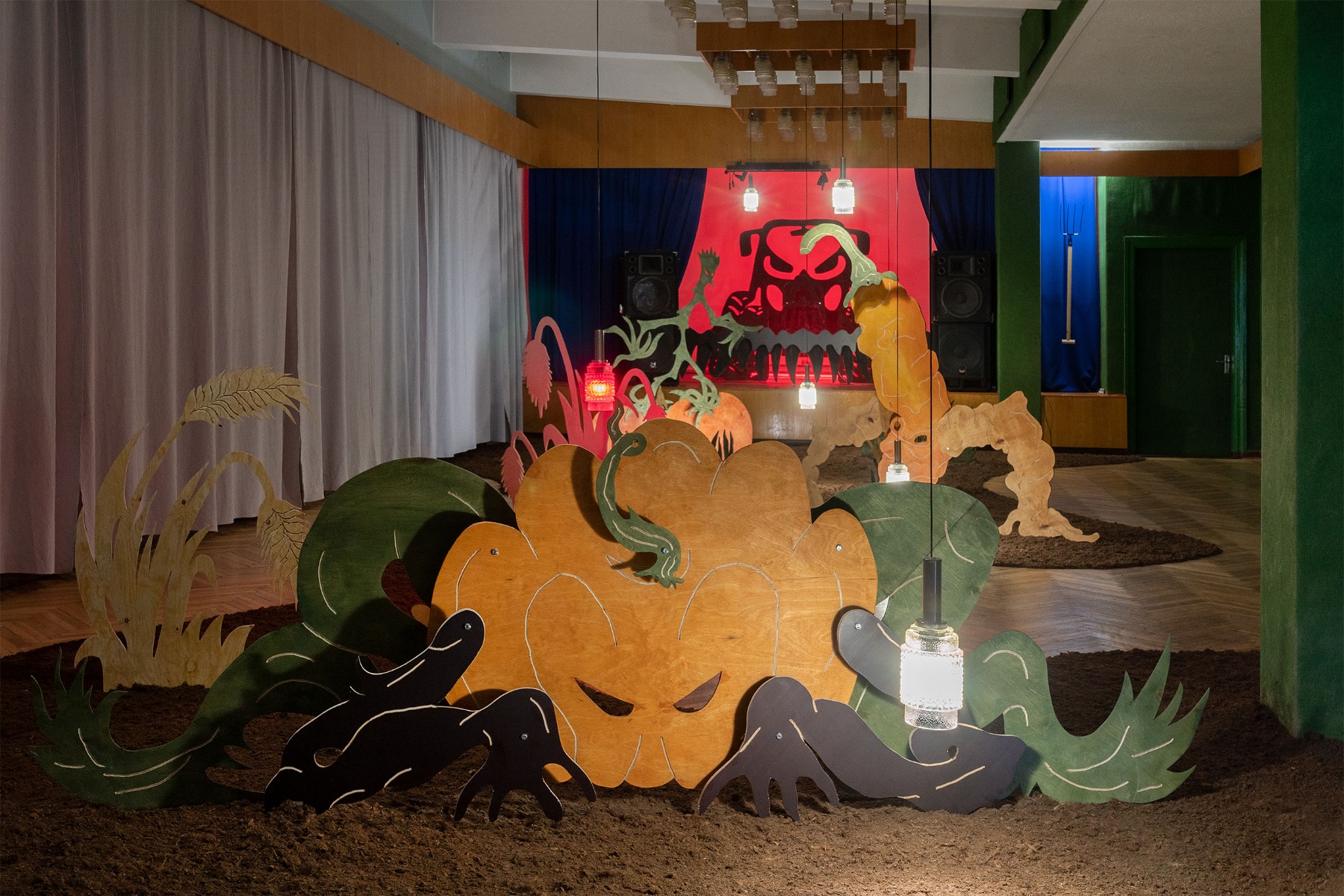
You mentioned earlier, however, that you’ve gone back to silk-screening, and I also understand that at Maboca, one of your and Breže’s goals was to use the computer as little as possible.
Yes, the Maboca project is really the beginning of my digital detox, which will now continue with silk-screening. Speaking of which, when I met Aleks, I actually had no idea that we were going to go in this direction. I’m also quite sure that Margrieta Griestiņa invited us both specifically as digital artists, with the idea of doing a multimedia installation. But Aleks quite unilaterally said that he won’t be sitting at a computer, and I didn’t really have any objections to that. In principle, we agreed from the very beginning that we wanted to make the whole installation together, so that it’s not like each of us is just creating separate parts that are then put together in the same room – so that it’s visible that there are really two artists working together. We didn’t want it to be obvious where my work starts and where his does. The choice of materials, or the format of the work, actually became clear after we visited the Maboca space. From the start, we saw that the stage in the room was huge, so we imagined that the whole exhibition would revolve around this part of the room. The first idea was to create objects inspired by early stage sets – how figurative and visually very clear they were. But when we went and saw the space in person, we realised that the stage alone would be too small for us. Then we had the idea that we could use the whole space itself, and it was immediately clear to Aleks that he wanted to work with wood. And truthfully, I just followed him. It was very cool. I think that’s the best thing you can take away from collaborations like this – that you do something differently than if you were doing it alone. I think I was very lucky to work as a team with Aleks because there was no one saying “no”. We worked without limits, creating big pieces and lots of them. At some point in the process of making a work, I’m used to the fact that you start to sort of look for problems, or you just spot them; but that wasn’t the case here, so we had an installation that was spread all over the gallery space. From the stage to the door, we hung lamps from the ceiling and filled the space itself with earth and made planting beds.
Līga Spunde. Last Harvest. 2022. Maboca gallery, Madona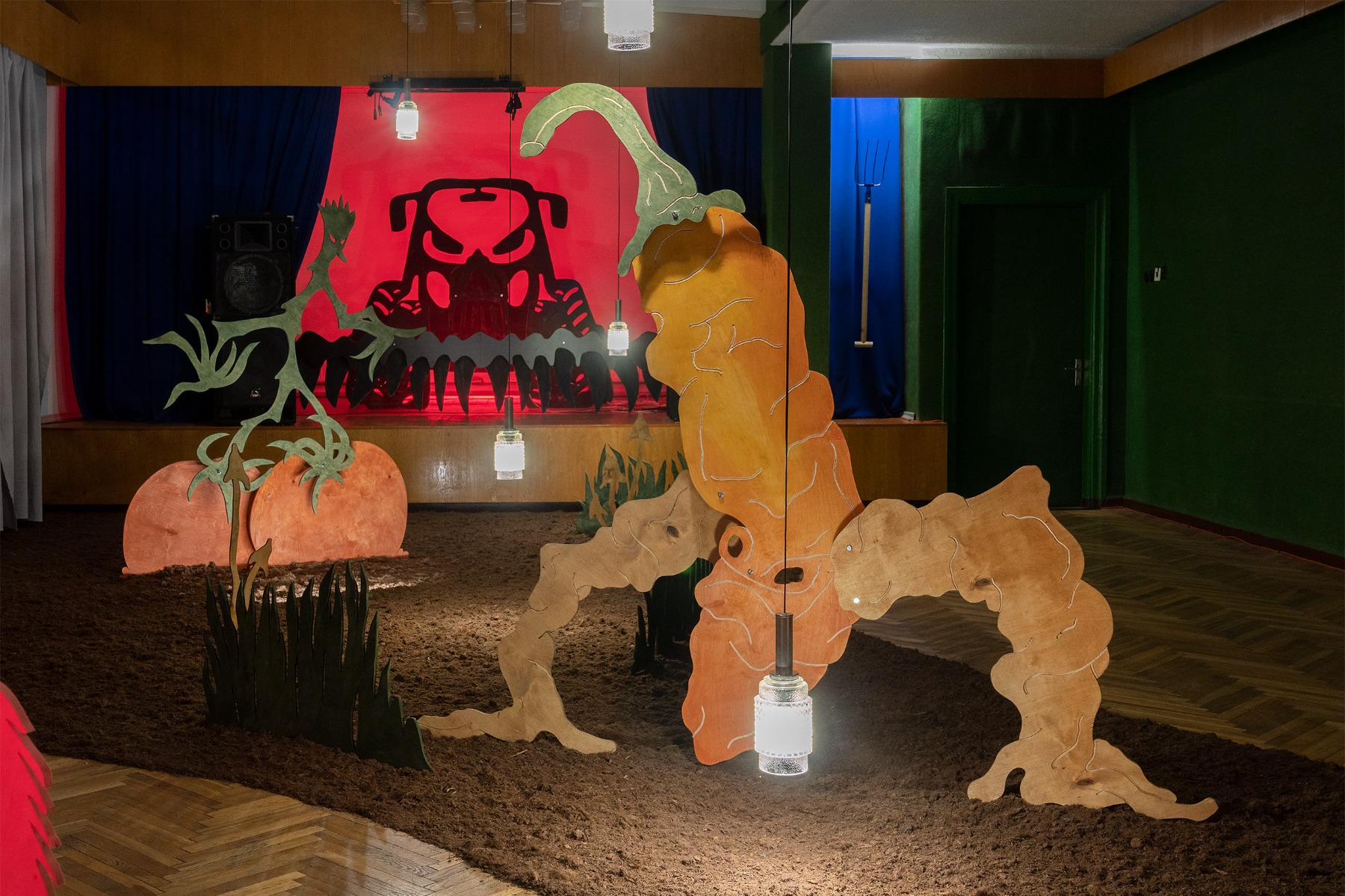
So it follows that autumn is the main theme of Last Harvest?
Yes, because when Margrieta proposed this exhibition to us as its curator, she said that the Maboca gallery is different from other galleries in that their exhibition programme is seasonal. So we were offered an autumn theme, which Alex and I took very seriously – specifically, as harvest time. We didn’t get very far in terms of fantasy – we chose to stay with the “vegetable men”. But seriously, I think we achieved our original idea – to create something like early-phase stage characters and develop them into a really ambitious installation that also does not fail in getting across a message that critiques current events.